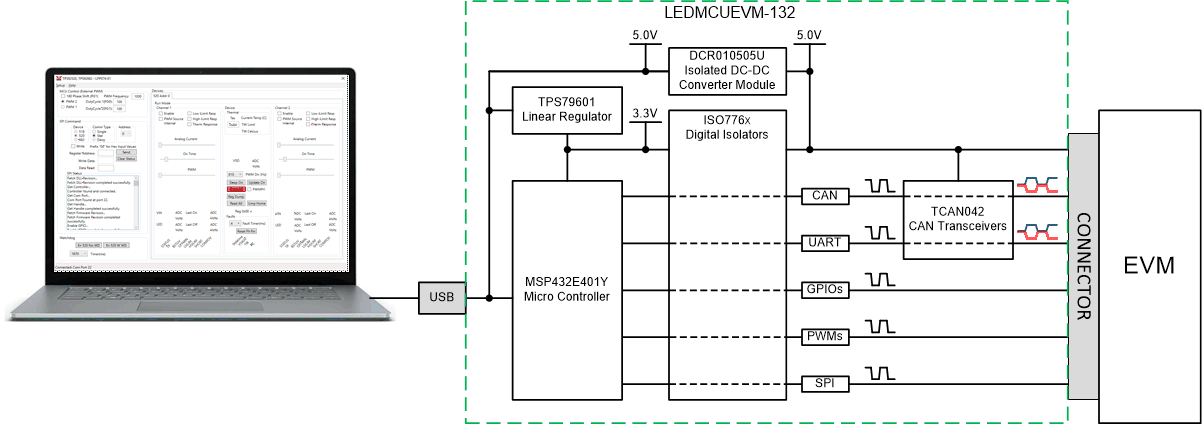SLAU834 October 2020 ISO7760 , ISO7762 , MSP432E401Y , TPS92520-Q1 , TPS92682-Q1
- Trademarks
- 1Description
- 2Features and Specifications
- 3Schematic, PCB Layout, and Bill of Materials
- 4Software
-
5LEDMCUEVM-132 Power UP and Operation
- 5.1 GUI Start-up
- 5.2 MCU Control Window
- 5.3 SPI Command Window
- 5.4
GUI Devices Window and Example Connections and Power Up
- 5.4.1 TPS92520EVM-133 Connections and Power UP
- 5.4.2 TPS92520EVM-133 Devices Window
- 5.4.3 TPS92518EVM-878 Connections and Power Up
- 5.4.4 TPS92518EVM-878 Devices Window
- 5.4.5 TPS92682EVM-069 + TPS92520EVM-133 Connection and Power UP
- 5.4.6 TPS92520, TPS92682 - LPP074 - E1 Devices Window
- 5.4.7 TPS92682EVM-069 + TPS92520EVM-133 + TPS92662EVM6-901 Connection and Power UP
- 5.4.8 TPS92662EVM6-901 Devices Window
2 Features and Specifications
The LEDMCUEVM-132 provides a host of features that allow it to be used with a variety of EVMs and for the easy evaluation and debug of devices and systems.
A SPI bus that supports up to six devices is provided and is accessed via J6, J9, and J12 connectors. It comes from the MCU (MSP432E401Y) through a digital isolator to the connectors. J12 can be used with debug probes or can be mated to a connector that uses a standard 100-mil header.
There are two pairs of PWM signals (PWM1 + PWM2 and PWM3 + PWM4) that can be used for PWM dimming of supported devices. These signals support up to 4 kHz operation and have the ability to be phase shifted by 180 degrees. J12 is a standard 100-mil head that can either be used for probing or to mate with a standard 100-mil connector.
Five GPIOs are provided and depending on the EVM selection the GPIOs are either enabled or disabled. See the user's guide of the EVM for more details.
The MCU generates UART commands that are used by the TPS92662 lighting matrix manager device. The single-ended communication is passed through a digital isolator and into a CAN transceiver to generate a differential signal that is commonly used in noisy environments. Either the single-ended UART signals are available via J4 header or the differential CAN signals are available by header J3.
There is an isolated 5-V supply that is created from the USB bus (5 V) and is supplied to the secondary side to power the digital isolators, CAN transceivers, and is passed on to other EVMs as V-ISO. Not all EVMs use this supply. Some have their own supplies separated from the LEDMCUEVM-133.
The LEDMCUEVM-133 supports firmware updates by the USB connection to the PC.
If the customer wants to develop their own firmware for the MSP432E401Y, then they have that ability to do that by using J7 and the XDIS110 JTAG Debug Probe.
The MSP432E401Y can also be connected to the Emulator connections of an external MSP-EXP432E401Y LaunchPad using J5.
The LEDMCUEVM-132 has a connection to the CAN bus of the MSP432 and it is also attached to a CAN transceiver to generate a CAN signal. This hardware is not yet supported by the GUI.
 Figure 2-1 High-Level Diagram of the LEDMCUEVM-132.
Figure 2-1 High-Level Diagram of the LEDMCUEVM-132.